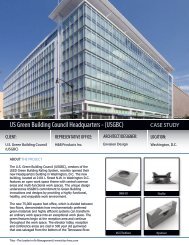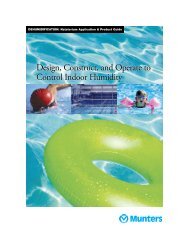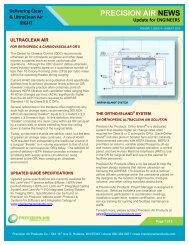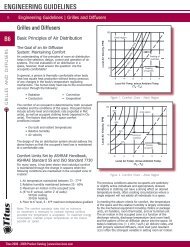Titus 2008 - 2009 Product Catalog | www.titus ... - Texas Air Products
Titus 2008 - 2009 Product Catalog | www.titus ... - Texas Air Products
Titus 2008 - 2009 Product Catalog | www.titus ... - Texas Air Products
You also want an ePaper? Increase the reach of your titles
YUMPU automatically turns print PDFs into web optimized ePapers that Google loves.
ENGINEERING GUIDELINES<br />
B<br />
B44<br />
TERMINAL CONTROLS AND ACCESSORIES<br />
Engineering Guidelines | Terminals, Controls and Accessories<br />
Control Operation<br />
in Terminals<br />
Damper Operation<br />
Linearity (Figure 61) is the ideal<br />
characteristic for most damper<br />
applications. How nearly linear<br />
the operation is depends upon the<br />
percentage of the overall system<br />
pressure drop contributed by the wide<br />
open damper. Pressure independent<br />
control operations eliminate the effect<br />
of nonlinear dampers, but simulate<br />
the effect of a true linear damper<br />
to the system. For a linear damper<br />
characteristic, the damper is sized to<br />
contribute about 10% of the overall<br />
system resistance. Also (Figure 62),<br />
actuator torque must be sufficient<br />
to close the damper under all design<br />
conditions. In <strong>Titus</strong> terminals, the<br />
torque is always more than adequate.<br />
Direct Acting/Reverse Acting<br />
Pneumatic Thermostat Action<br />
In the direct acting pneumatic<br />
thermostat (Figure 63), a room<br />
temperature increase causes<br />
a corresponding increase in<br />
thermostat output. In the reverse<br />
acting thermostat (Figure 64), the<br />
sequence is the opposite. Because<br />
of these characteristics, direct acting<br />
thermostats are often used for cooling,<br />
reverse acting for heating. (With<br />
electronic systems, this term has<br />
no application.)<br />
Direct Reset/Reverse<br />
Reset Pneumatic Velocity<br />
Controller Action<br />
In the direct reset pneumatic velocity<br />
controller (Figure 65), an increase in<br />
thermostat output pressure causes a<br />
corresponding increase in controller<br />
cfm setting. The damper will open and<br />
close to maintain this cfm when duct<br />
pressures change. In the reverse reset<br />
controller (Figure 66) the same action<br />
results from a decrease in controller<br />
cfm setting.<br />
<strong>Titus</strong> <strong>2008</strong> - <strong>2009</strong> <strong>Product</strong> <strong>Catalog</strong> | <strong>www</strong>.<strong>titus</strong>-hvac.com<br />
100<br />
%<br />
cfm<br />
Oversized<br />
Damper<br />
Damper Opening, %<br />
Damper<br />
Sized for<br />
Linear<br />
Characteristic<br />
Figure 61. Linear Damper Operation Figure 62. Damper Torque Requirement<br />
100<br />
%<br />
cfm<br />
(Cooling)<br />
Room Temperature Increase<br />
Figure 63. Direct Acting Thermostat<br />
Action<br />
100<br />
%<br />
cfm<br />
(Cooling)<br />
Direct<br />
Acting<br />
Thermostat<br />
Direct<br />
Reset<br />
Thermostat<br />
Min<br />
Room Temperature Increase<br />
Max<br />
Figure 65. Direct Reset Pneumatic<br />
Velocity Controller<br />
100<br />
%<br />
cfm<br />
%<br />
cfm<br />
(Cooling)<br />
Maximum<br />
Torque<br />
Required<br />
Torque<br />
Open Closed<br />
Face Area x Total Pressure<br />
100<br />
Reverse<br />
Acting<br />
Thermostat<br />
Room Temperature Increase<br />
Figure 64. Reverse Acting Thermostat<br />
Action<br />
%<br />
cfm<br />
(Cooling)<br />
100 Max<br />
Room Temperature Increase<br />
Direct<br />
Reset<br />
Thermostat<br />
Min<br />
Figure 66. Reverse Reset Controller








